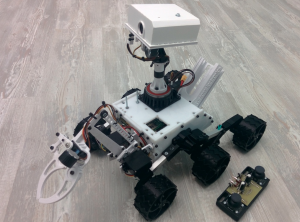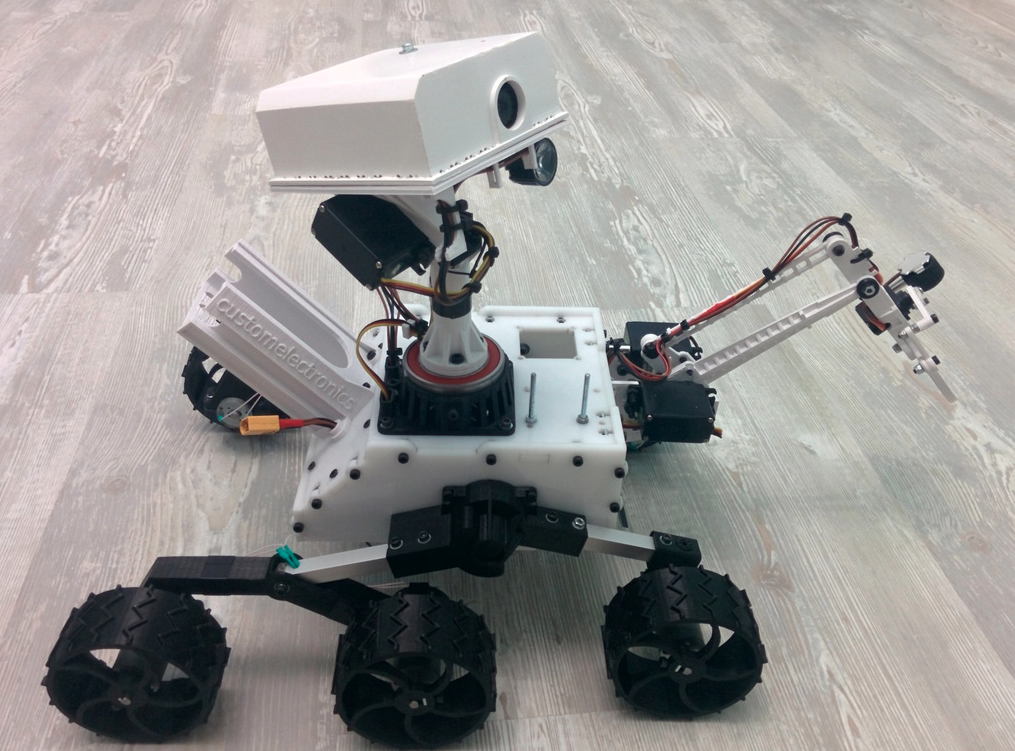 One of my favorite parts of this job is seeing what people do with 3D printing technology, not for money or as a job, but rather just because they can. Over the years I’ve seen all sorts of amazing 3D printed artwork, strange or humorous statues, and clever solutions to unique problems that could only be solved with a 3D printer. But my absolute favorite is when people use 3D printed parts and use them to create their own unique robots.
One of my favorite parts of this job is seeing what people do with 3D printing technology, not for money or as a job, but rather just because they can. Over the years I’ve seen all sorts of amazing 3D printed artwork, strange or humorous statues, and clever solutions to unique problems that could only be solved with a 3D printer. But my absolute favorite is when people use 3D printed parts and use them to create their own unique robots.
Sergey Grishchenko is a hardware and software developer from Ural, Russia and he is pretty fond of robots himself. He also says that he’s a pretty big fan of things made by NASA and Roscosmos (the Russian counterpart to NASA), just like any engineer. That love of space is what prompted him to use his robotics knowledge and 3D printer to build his own small, Earthbound version of the Curiosity Rover.
“I always wanted to to create a rover with a moving camera and arm,” Grishchenko tells 3DPrint.com. “What would be a better prototype than a real rover with these functions?”
Grishchenko’s baby version of Curiosity may not be able to survive on the lifeless surface of another planet, but it is still equipped with everything that it needs to explore the lifeless surface of your living room floor. Lil’ Curiosity is equipped with six wheels just like its big brother that let it climb over obstacles and uneven surfaces. It has an articulated claw arm that can pick up your socks or snap closed menacingly while you chase after your dog. It can transmit video so you can see what it sees and it even has spotlights to illuminate the dark corners of your home while in search of new life forms.
“It can pour drinks or be a telepresence robot. It’s all about imagination and programming skills. In fact, I developed it because I can. It does not have a specific purpose today. Just a fun toy. My wife says that it looks like Wall-E,” Grishchenko told us via email.
The rover is connected to a PC using Bluetooth and operated by a remote that connects to the PC via USB. The remote allows all six wheels to be moved independently, so Curiosity has a full range of movements and motion. It has a range as far as the Bluetooth connection will allow and because the head gimbal is also completely motorized you can move the camera in virtually any direction that you need and watch back on your computer screen.
Here is a video of Grishchenko’s Curiosity Rover in action:
And here is a video of the Curiosity Rover showing off its various functions:
Almost all of the rover is constructed from 3D printed parts, including the wheels, the claw arm, the wheel suspension, the rover’s body, and even the box that contains the remote electronics. The main electronic part that Grishchenko used was the LinkIt One dev board that connects the rover to the computer. It also lets him run the DC motors that run his rover as well as all of the drivers involved.
While Grishchenko has yet to release a complete tutorial on building your own rover, he has put all of the 3D printable parts up on Thingiverse so experienced makers can try their hands at building their own. What do you think about the at-home, 3D printable version of Curiosity? Let us know over on our Working 3D Printable Curiosity Model forum thread at 3DPB.com.
Subscribe to Our Email Newsletter
Stay up-to-date on all the latest news from the 3D printing industry and receive information and offers from third party vendors.
Print Services
Upload your 3D Models and get them printed quickly and efficiently.
You May Also Like
3D Printing News Briefs, June 7, 2025: Digital Inventory, Thermal Management Solutions, & More
In this weekend’s 3D Printing News Briefs, UK-based 3D printing bureau 3D People responds to global instability, and AEWIN chose Fabric8Labs’ technology for advanced thermal management solutions. We’ll end with...
XO Armor’s Custom 3D Printed Orthotics Will Cater to Military & Athletes
Several years ago, the Auburn University Biomechanical Engineering Laboratory (AUBE LAB) spawned XO Armor, which uses 3D printing to help college sports teams heal faster. XO Armor uses desktop Material Extrusion...
3D Printing News Briefs, May 21, 2025: Medical Training Models, Connectors, Makerspace, & More
We’re starting with research and medical in today’s 3D Printing News Briefs, as a research team from Caltech is using sound to 3D print deep inside living tissue, and rural...
Low-Cost Binocular Indirect Ophthalmoscope Made with CAD Software & Bambu Lab X1C
3D printing is increasingly used in the fabrication of diagnostic equipment, including ophthalmology, which is a medical specialty that deals with the diagnosis and treatment of eye conditions and diseases....



































